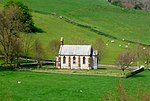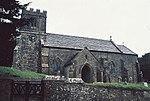Cruxton
Dorset geography stubsHamlets in Dorset

Cruxton is a hamlet in the English county of Dorset. It lies eight miles north-west of the county town of Dorchester, and one mile south-east of the village of Maiden Newton. It is sited on the west bank of the River Frome, amongst the chalk hills of the Dorset Downs. According to the Dorset author and broadcaster Ralph Wightman, the old house in the hamlet "was certainly a manor. William Crox gave thirty marks to have seizin of the vill in 1205."The Froome Valley Trail long distance foopath runs throught Cruxton.
Excerpt from the Wikipedia article Cruxton (License: CC BY-SA 3.0, Authors, Images).Cruxton
Cruxton Lane,
Geographical coordinates (GPS) Address Nearby Places Show on map
Geographical coordinates (GPS)
| Latitude | Longitude |
|---|---|
| N 50.76671 ° | E -2.56572 ° |
Address
Cruxton Lane
Cruxton Lane
DT2 0EA , Maiden Newton
England, United Kingdom
Open on Google Maps








